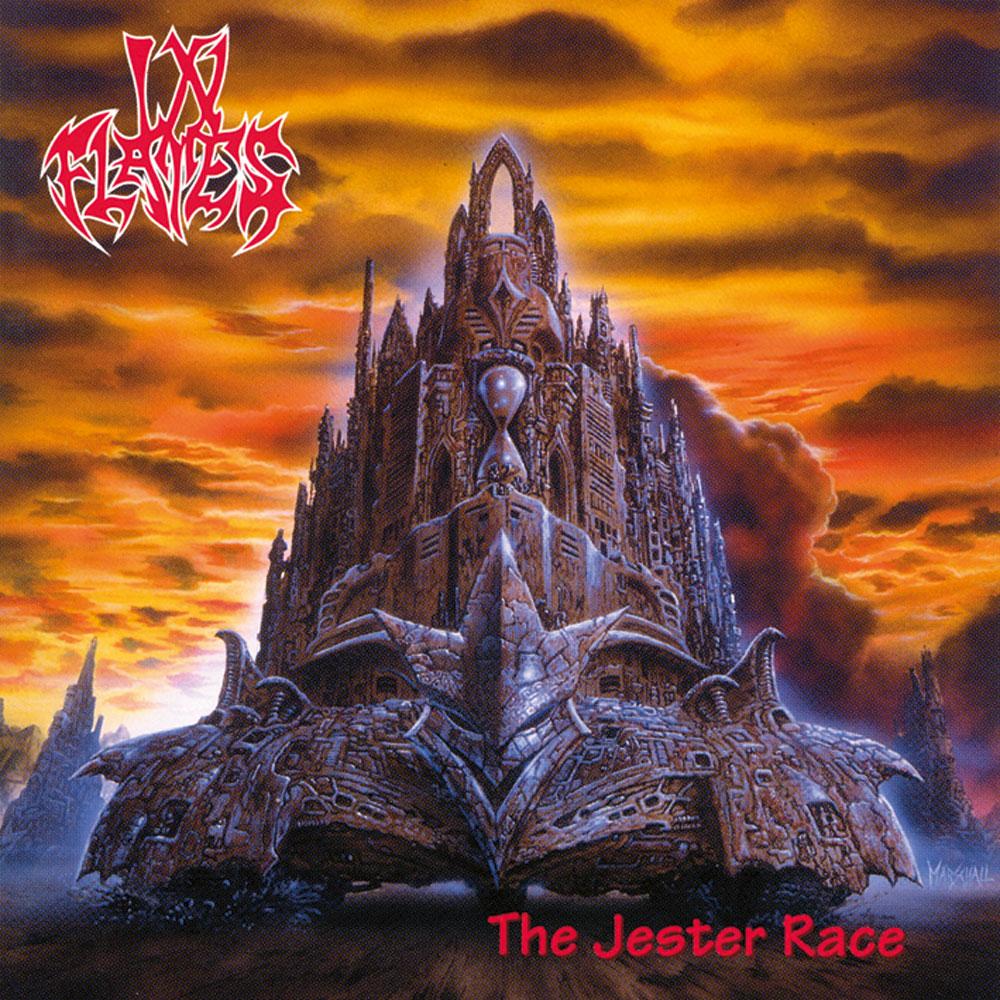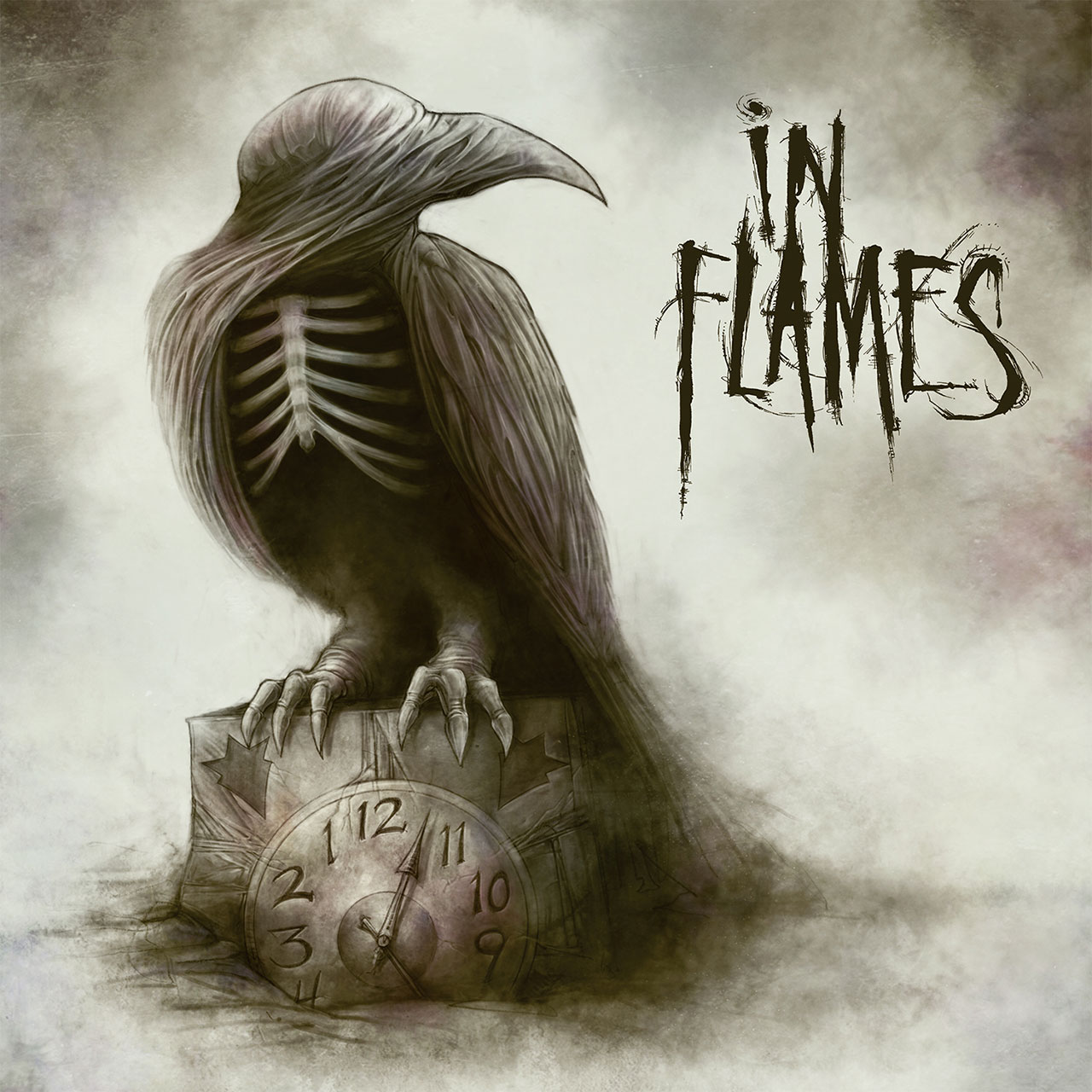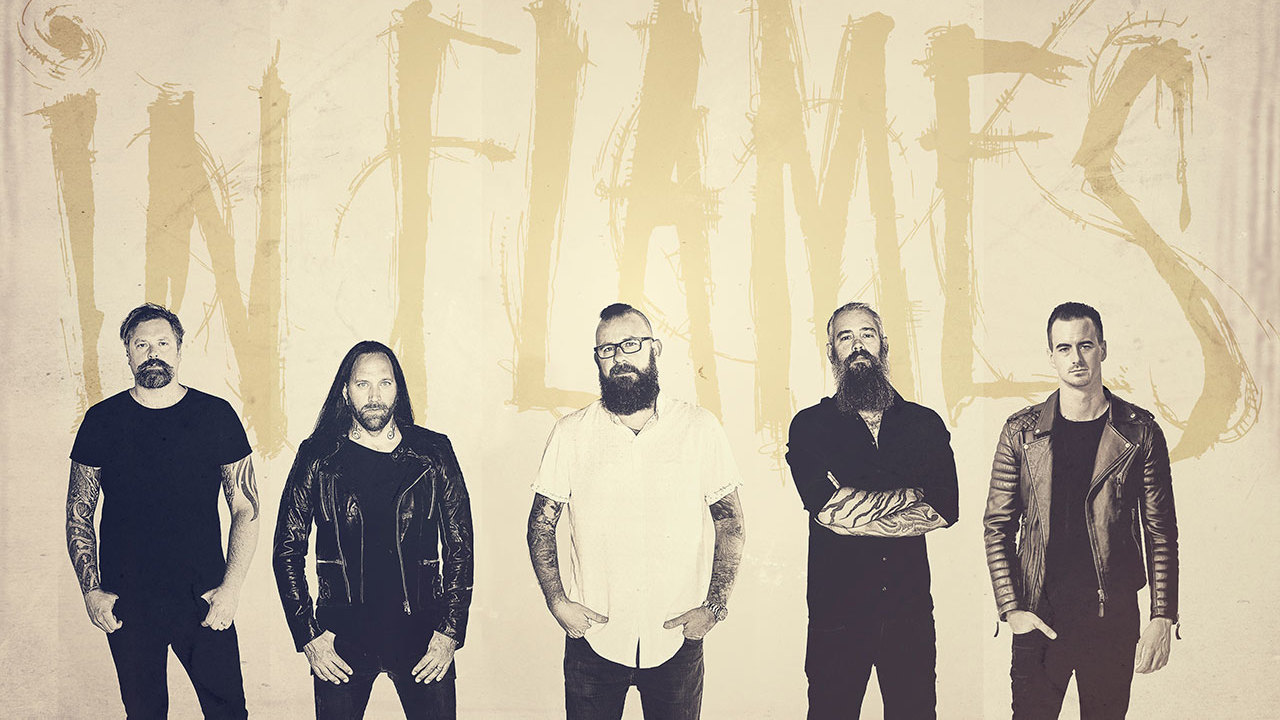Perhaps you heard In Flames on a video game or supporting a band way younger than them. Maybe you’re a die-hard, old-school fan who left the band behind following their numerous, sometimes questionable stylistic changes. But now they’re back and they’re packing a new record, Battles. While we sift through the Swedish melodic death metal legends’ back catalogue in preparation for their Avenged Sevenfold support slots – In Flames, Disturbed and Avenged in one night is going to end your larynx – here are 26 things you should know about them.
A is for… Awards
While the traditional Grammy Awards remain a bit of a farce, Sweden’s going the right way about it. Over the years, In Flames have received four of their home country’s Grammis Awards; one apiece for Best Hard Rock/Metal Album with Soundtrack To Your Escape, A Sense Of Purpose and Come Clarity, plus one thrown in there for the Swedish Export Award. They also won Best International Band in Hammer’s very own Golden God Awards back in 2008. Just saying.
B is for… Battles
Another new album and another new chance to offend their old fans, Battles isn’t going to please the guy/girl who only listens to In Flames’ Subterranean EP on vinyl. Sorry, tape. Vinyl’s too mainstream now. Point is, the band’s twelfth LP isn’t going to be for everyone, but it’s a satisfying merge of Come Clarity’s barbed edges and the radio-bothering, sickly sweet singalongs In Flames have pushed for the last two records. Björn Gelotte and Niclas Engelin’s dual guitar work is more in keeping with the Iron Maidenisms of yore and Anders Fridén’s bringing back those screams in a biiiiig way. Although it’s not the best In Flames release, Battles is reassuring to anyone who thought they lost their way after Come Clarity.
C is for… Come Clarity
We could’ve listed Colony or Clayman here, but you probably already know they’re classics. Come Clarity, meanwhile, is the apex of In Flames’ second phase. The melodious death metal racket was reintroduced alongside clean vocals and radio-ready structures, gluing everything together to create a cohesive, callous classic. Take This Life, Vanishing Light, Dead End, Leeches, Crawl Through Knives… This record’s got the tunes to rival In Flames’ copycats and the primal, gut-punching “BLEURGH!” to hold its own within the band’s esteemed catalogue. An essential purchase for any metal fan – it’s worth buying for the artwork alone, penned by Sepultura and Converge colourer Derek Hess.
D is for… Depeche Mode
Yes, it was funny when Marilyn Manson covered Depeche Mode’s Personal Jesus and yeah, Johnny Cash’s version of the same song was great, but it’s so hard to cover DM and make it your own. The excellent Meat Beat Manifesto covered Everything Counts in 1998 and failed to put their own spin on it, maybe because In Flames’ rendition came out the year before and wiped the floor ready for MBM to slip over on. The last ‘proper’ track on In Flames’ Whoracle, this cover’s rampant with riffs and features Fridén’s first proper punch at melodic vocals, setting him up to become the stage-ready frontman he is today.
E is for… Electronics
There’s a reason that some of In Flames’ older fans never cease to type stuff like, “Why didn’t they play Artifacts Of The Black Rain?” and that’s because they don’t like change. Which, when listening to latter day In Flames, is understandable. The keyboard-laden litanies within 2002’s Reroute To Remain and Soundtrack To Your Escape in 2004 had the band throw most of their melodic death metal in the bin, replacing it with mid-paced, blippetty-bloppetty alternative metal that still kicked arse but yeah, it might’ve been a tough sell to the fans with full Jester Race face tattoos. After a brief resurgence with Come Clarity, the extreme elements were ushered out again, rendering In Flames a rock band with hints of metal amidst a sea of modern, glossy electronics.
F is for… Fridén, Anders
Once a dreadlocked demon and now more a bearded beast, Anders Fridén joined In Flames as they recorded 1996’s The Jester Race a year prior. Funnily enough, he left the mic at Dark Tranquillity to join In Flames; Dark Tranquillity guitarist/vocalist – and then-In Flames singer – Mikael Stanne reports that Fridén was fired from his band before joining In Flames, meaning they effectively swapped jobs. Over the two decades since, Fridén’s grown as a live and studio force, handling the crowd like loose change in his pocket and having more of a hand in the production aspect of his band’s music. He’s also said that, while the band’s sound continues to evolve and piss off a certain demographic of their fans, they’ll “never do a country album.” Which is good, we guess, although if they were all in the vein of Metaphor then we’d be well up for it.
G is for… Gothenburg
Breeding ground of great bands, terrible jokes and Crazy Frog, Göteborg, Sweden is In Flames’ birthplace and the subject of their latest live release, Sounds From The Heart Of Gothenburg, where they played inside the city’s Scandinavium to 10,000 fans. The city spat out Dark Tranquillity and At The Gates too, thus giving the ‘Gothenburg sound’ – we’ll discuss that later – a proper platform. Gothenburg’s also played host to the annual Metaltown festival since 2004, with In Flames headlining in 2012 – Slayer and Marilyn Manson were underneath In Flames on that lineup poster, we might add.
H is for… Hårgalåten
An instrumental track popping up on debut LP Lunar Strain, Hårgalåten is a traditional piece of Swedish folk music to accompany the Hårga dance and a juicy piece of legend. Because we all love those, right? As the story goes, the Devil disguised himself as a fiddle player and got all the local kids in Hårga to dance themselves to death until only their bones remained. It’s a pretty metal premise to begin with, but In Flames dropped a little electric guitar in there to beef it up. Culture, that.
I is for… Iwers, Peter
Bass extraordinaire Peter Iwers fell down a mountain when he was younger – true story – so he decided to become a mountain; his rumbling, meaty bass underpinning every In Flames album since Colony. His tremendously tight performance on Come Clarity, in particular, gallops with the dirtiest of tones to riposte the squeaky-clean guitars.
J is for… Jester Head
Iron Maiden have Eddie, Megadeth have Vic Rattlehead, Disturbed have, er, the Guy – could they really not have just given him a name? Even, like, Dave or something? – and In Flames have the Jester Head. Originally appearing on The Jester Race – the band’s second LP and one of the greatest melodic death metal albums ever – it’s since become a mascot to unite In Flames’ fans across the globe through a flurry of album covers, merchandise and tattoos of varying quality.

K is for… King In My Own Mind
Fridén screaming “a king in my own mind” must have irked old-school fans considering the song it derives from, The Quiet Place, is about as royal as a pug masquerading as a corgi. Soundtrack To Your Escape harbours some genuinely moving, underrated gems from In Flames’ mid-period… but The Quiet Place just isn’t one of them. A glorious Daniel Svensson drum fill and spooky keyboards stop this track from being truly turgid but, by In Flames’ stupidly high standards, The Quiet Place just isn’t up to it. A king in your own mind only, mate.
L is for… Lyrics
Much like their musical output, In Flames’ lyrical musings have morphed over time – as was duly noted, on both counts, with The Quiet Place. Early material revolved around the end of the world and all things bloody ‘orrible; Whoracle was actually a concept album about the prelude, occurrence and aftermath of the apocalypse. Due to his, at the time, limited English, Fridén had his lyrics transcribed by Dark Tranquillity’s Niklas Sundin, a partnership that would continue up to and including Colony. From that, Fridén’s lyrics became more introspective and personal, often writing about, ugh, feelings – something a few fans had a hard time getting behind. Still, Come Clarity’s ode to Fridén’s daughter is lovely, as is his recent lament to his son on Here Until Forever from Battles.
M is for… Melodic Death Metal
So, we’ve banged on about it for this whole A-Z; what exactly is melodic death metal? Well, we’re starting on the right track with In Flames – the ‘Gothenburg style’ originated with them, Dark Tranquility and At The Gates all rubbing shoulders and heading into the studio with god-behind-the-knobs Fredrik Nordström. In Flames’ then-guitarist Jesper Strömblad had a vision for the band with Lunar Strain: meld Iron Maiden’s melodic guitar lines with luscious acoustic passages and savage, unhinged death metal. We think he did all right.
- In Flames' track-by-track guide to new album Battles
- In Flames album review – Battles
- In Flames: Anders Fridén's Guide To Life
- Why I Love Tool...By In Flames' Anders Fridén
N is for… No Original Members
Nope. Not one. Since Strömblad left in 2010, In Flames ceased to contain any original members. Saying that, Fridén’s been knocking about since their strongest record, The Jester Race, and Iwers only came two years later following Whoracle’s completion. But the songs still bang live so it doesn’t really matter, right? Right?
O is for… Only For The Weak
IT’S JUST ONE OF THE GREATEST SONGS EVER, ISN’T IT?! Yes, yes it is.
P is for… Pendulum
Drum and bass delinquents Pendulum were always in on the joke – “Okay, fuck it. I lied. It’s drum and bass. What you gonna do?” – but their third record, Immersion, crawled straight to the top of the UK album chart, bringing In Flames and, bizarrely, prog legend Steven Wilson along for the ride. Very odd. Self vs. Self had In Flames hashing it out against Pendulum’s big-arsed beats and, to be honest, it’s probably the most furious thing they’ve done post-Come Clarity.
Q is for… Qemists, The
Yep, another electronic one. On the 2014 reissue of In Flames’ 10th full-length, Sounds Of A Playground Fading’s, Brighton genre-benders the Qemists provided a dubtastic remix of Where The Dead Ships Dwell. A lot of In Flames fans were with it until the wob came in. We like it, mind you, and the Qemists recently turned in an intriguing cover of Korn’s Blind for Hammer’s 30th anniversary celebrations. Lovely lads. Just don’t let them near Lunar Strain.
R is for… Raven
Sounds Of A Playground Fading marked yet a further departure from the band’s root sound; the cover art, however, was another story. Etched by nightmarish scribbler Dave Correia, the album’s cover depicts a skeletal raven perched atop a clock, its face shrouded in folds of ghostly skin. The bony bird’s since been tattooed on scores of fans across the globe and there’s even been a sculpture of it by brothers Mange and Viggo Lando – they also had a crack at A Sense Of Purpose’s Owl Boy, and that’s pretty insane too.

S is for… Strömblad, Jesper
The man who started it all, Strömblad was a constant reassurance whenever In Flames appeared to stray; even if the overall musical banquet wasn’t to your taste, you knew the riffs would at least be an appetiser before the plate full of shit. Not that it was shit – each of those post-Clayman records have highlights, just some, er, less than others. Anyway, Strömblad left in 2010, putting it down to his struggles with alcohol and the fluctuating nature of In Flames’ sound: “All respect to In Flames and their new approach, but for me the band was a guitar/riff based melo-death band. And it’s not anymore, but [there’s] still amazing musicianship and I don’t think it’s wrong. But it’s not the vision I had when we started out.” Fair enough, although he did recently refer to In Flames as a “sinking ship.” After leaving the band, he joined the Resistance, a gnarly, hardcore-spattered death metal band festooned with riffs thick enough to cave in your fucking skull and use your brain as a spacehopper. That band subsequently split this year, but In Flames’ Iwers has confirmed that he’s working on a new band with Strömblad. Which is nice.
T is for… Tokyo Showdown, The
Just look at that setlist. Yeah, the new stuff’s good but… that setlist. The Tokyo Showdown was recorded during In Flames’ 2000 Japanese tour so, as such, only included material from Clayman and before – anybody got a flux capacitor going spare? Aside from ripping through five albums’ worth of undeniable classics, the band also burst into a rendition of Slayer’s Raining Blood and, while extremely lovely and all that, they’ve since been trumped by fellow countrymen Refused’s live rendition, the victory cemented with frontman Dennis Lyxzén’s unbearable dancing.
U is for… Unplugged
You probably won’t see At the Gates doing this anytime soon – just imagine Tomas Lindberg screaming “Nauseating Pain!” backed by a lone bongo – but In Flames continue to refute the box everyone tries so hard to shove them in. Ahead of Siren Charms’ 2014 release, the band performed a couple of stripped-back numbers for iRockRadio in New York’s Bowery Electric; the band’s first acoustic gig, as it happens. This was built upon a few weeks later when In Flames played Through Oblivion on talk show Skavlan, acoustic and backed by a string section. Lovely stuff.
V is for… Vinyl
We’re all suckers for limited vinyl, so it’s a bit of an arse-ache that In Flames have unveiled their career-spanning vinyl boxset for release on December 9, just before bloody Christmas. Comprising all studio albums up to and including Sounds Of A Playground Fading plus the Black-Ash Inheritance EP and Demo ’93, the inventively titled In Flames: 1993 – 2011 is available in a multitude of coloured variants and will set you back about 150 quid. It does look really pretty, though…
W is for… Whisky
Fridén is an avid collector of whisky and DVDs – the ultimate combination, some believe – so it makes sense that In Flames would eventually get their own booze. Distilled in 1973, the year Fridén was born, Glenfarclas’ single malt Scotch whisky is an admirable 58.8% and limited to just 189 bottles worldwide. Another 60% bottle, limited to 234 units, was also made available. Fancy, huh?
X is for… eXtra Tracks
Quite a few bands have been guilty of cobbling together half-arsed demos and rereleasing them as ‘previously unheard rare tracks’ and so forth, but In Flames’ bonus content is, for the most part, pretty great. Abnegation, Tilt and Eraser were all mercilessly removed from A Sense Of Purpose’s regular edition, yet each remain stronger than most of that record’s bulk; Lunar Strain standout Clad In Shadows is given the Fridén treatment on differing editions of Colony and Whoracle; deluxe versions and rereleases of Clayman come armed with a raucous rendition of Strong And Smart by Swedish punks No Fun At All. Basically, it’s worth shelling out the extra bob for the sheer breadth of quality through In Flames’ bonus material.
Y is for… Your Bedtime Story Is Scaring Everyone
Come Clarity climaxes with the limb-flailing Vanishing Light before plunging the listener into Your Bedtime Story Is Scaring Everyone: an ambient, pulsating soundscape that eventually erupts into droning chug and a suitably seething vocal from Fridén. Proof that even though they ditched the folky leanings of records past, In Flames could still conjure an atmosphere deeper than just, well, something to make your head bang.
Z is for… Zeitgeist
In Flames are part of something bigger. Swedish melodic death metal was a game-changer, but neither At The Gates, Soilwork, Arch Enemy, Dark Tranquillity nor any of the others packed that undeniable catchiness In Flames harnessed. From the bowels of Gothenburg, this little band stood atop a mountainous genre that was burrowed into and its ore liberally nicked by bands like Killswitch Engage, Trivium, Avenged Sevenfold, Bullet For My Valentine and the like. In Flames captured the zeitgeist of this movement, this blending of the old and the new, the melodic and the monstrous. Even if you’re not a fan of the new direction, credit’s due where credit’s due. Kneel.
In Flames’ new album Battles is out now, via Nuclear Blast.

